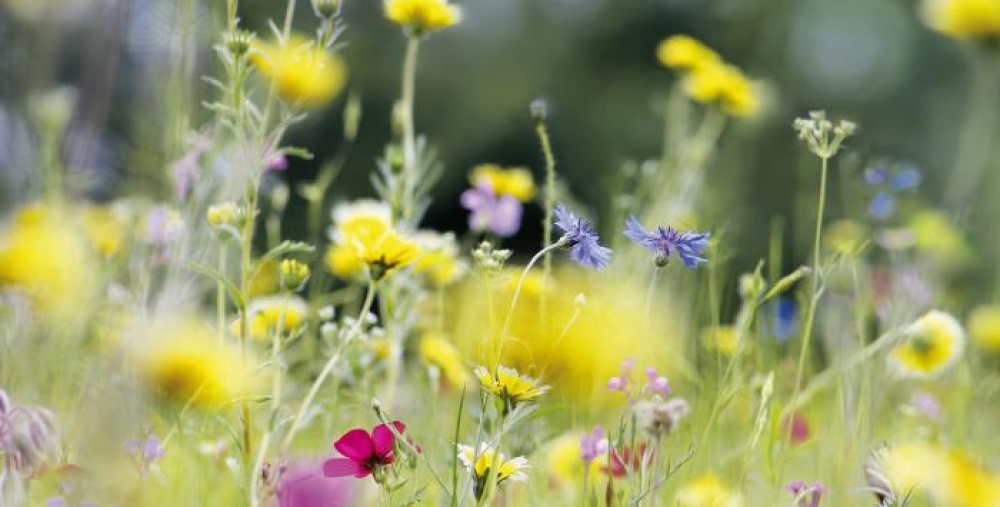Why These Three Wildflower Meadows in the North are Being Conserved

HRH The Prince of Wales launched an ambitious effort to officially recognise and conserve 60 flagship meadows in 60 counties across England in 2013, three of which are in the North. Living North finds out more
Wonderfully idyllic, red, green and blue wildflowers flutter before your eyes, as delicate stems of oxeye daisies wrap themselves around tall scarlet poppies, and bright yellow buttercups dance in the wind. It’s easy to get lost in the romantic notion, but how many of us can say we’ve actually had the pleasure of visiting a verdant wildflower meadow for ourselves?
With every new generation, wildflower meadows are becoming the stuff of fairytales, lingering figments of imagination, alive only in books, paintings and poetry because of the changes in the way we use and treat the land.
Wildflower meadows are an essential part of our landscape, not least because of the vital role they play in supporting a variety of wildlife, flora and fauna. Tranquil wildflower meadows aren’t just stress-relieving spaces for humans.
Welsh farms often had what was known as a Cae Ysbyty, or ‘hospital field’ that was essentially a flower-rich pasture in which sick animals could roam or lie, many of which were said to recover from their illness or injuries faster than anywhere else.
Despite their rugged good looks and rural charm, meadows are man-made environments. Ancient wildflower meadows have been cut or grazed in the same way for centuries to become a haven for rare or endangered species of plants. The constant removal of growth reduces the level of nutrients in the soil, making it easier for wildflowers to thrive.
However, the increasing use of fertilisers together with modern farming methods has led to the decline in the number of wildflower species that once flourished in our fields, and as the flowers disappear, so do the pollinators that rely on them which in turn affects a wide range of birds and other creatures who feed on them.
According to Plantlife, a wild plant and fungi conservation charity, rare flowers such as the green-winged orchid and the lesser known butterfly orchid are thought to have decreased by almost half since the 1930s. Other common wildflowers such as adder’s tongue fern, moonwort and the frog orchid are said to be disappearing regionally at the rapid rate of up to one species per year.
Common wildflowers such as meadow buttercups, cowslips, red clover and oxeye daisies are also at risk from disappearing from our landscape much sooner than expected too. Meadows need careful management.
A meadow’s ability to thrive depends on numerous factors such as soil type, location and disturbance from animals, humans and nearby industries. Restoring a wildflower meadow to its former glory, or indeed creating a new meadow, is a painstaking process and success is never guaranteed. There are often recurring problems with deep-rooted perennial weeds and plagues of dock leaves which make establishing any of the more delicate meadow species near impossible.
According to Dr Trevor Dines, a Plantlife Conservation Manager, it is estimated that 97% of our wildflower rich meadows have been destroyed since the Second World War, which paints a grim picture of the Great British countryside, especially for future generations.
Even the wildflowers at the side of the road that brighten up our daily commute are under attack from modern-day living; instead of leaving the wildflowers to set seed, they’re mowed down in their prime, sprayed with poisons or smothered with cuttings so over time only the hardier weeds and thistles survive.
Seed growers, botanists and conservationists have long been working to save England’s flower-rich meadows and minimise the damage we cause, so the recent announcement of the Coronation Meadows scheme will have brought welcome to relief to those small few already striving to save them.
In late 2012, HRH The Prince of Wales announced plans for this ambitious nationwide project which sought to preserve the flower-rich meadows in every county across the UK to mark the anniversary of The Queen’s Coronation.
What better way to celebrate such a landmark anniversary than by celebrating and preserving something so quintessentially English as a wildflower meadow. There are hundreds of potential candidates up and down the country, but the first 60 to be chosen are outstanding examples of flower-rich grasslands which play a vital role in supporting our wildlife.
There are three Coronation Meadows in the North: Muker Meadow in North Yorkshire, Hannah’s Meadow in Durham and Piper Hole in Kirkby Stephen, Cumbria. Many of these meadows have survived the test of time because the area has been carefully managed and protected, usually by generations of one family.
Hannah’s Meadow, for example, was owned and farmed by Hannah Hauxwell for over 50 years using traditional farming methods that avoided the use of artificial fertilisers or re-seeding.
The oldest Coronation Meadow to be announced so far is Loughborough Big Meadow in Leicestershire which lies alongside the River Soar and supports numerous species of plant and wildlife. Loughborough Big Meadow is the only known site in the country where the nationally scarce narrow-leaved water-dropwort grows, which highlights the need to protect valuable sites such as this.
The Coronation Meadows project will do just that; from tiny ribbons of grassland to acres of luscious meadows, the identification of a Coronation Meadow in each county is hoped to be completed by the end of this year, resulting in 107 in total.
The second stage of the project aims to identify sites within each county where green hay and seed from the Coronation Meadow can be used to restore or recreate new meadows. Perhaps the most ambitious, but most valuable part of the project is the hope of mapping each and every one of the UK’s remaining meadows to help discover and protect rare species of plant. No such inventory currently exists, so conservationists certainly have their work cut out for them.
Hannah’s Meadow
Spanning 8.8 hectares, this stretch of grassland dates back to 1944 and contains a significant plant community such as the endangered adder’s tongue, marsh marigold, meadow foxtail and sweet vernal grass.
A haven for wildlife such as the lapwing, skylark and meadow pipit, the meadows and pasture at Hannah’s Meadow have evolved as a result of traditional farming practices over several centuries. Living alone at Low Birk Hatt Farm without the luxury of electricity or running water, Hannah Hauxwell was the subject of a hugely popular documentary called Too Long A Winter, which chronicled the back breaking work and harsh conditions Hannah faced while farming here.
Hannah retired in 1988 and the meadows are now a nature reserve. Midsummer is the best time to visit Hannah’s Meadows for the meadow flora, but visitors must share their view with the sheep who graze here. Hunderthwaite, Durham www.durhamwt.co.uk
Muker Meadow
Consisting of 12 meadows in total, four Muker Meadows have been recognised as Coronation Meadows. These are upland hay meadows situated in the beautiful Yorkshire Dales, where wildflower grasses such as wood crane’s-bill, melancholy thistle, pignut and sweet vernal grass grow in abundance, providing welcome nutrients to birds, bees and the Swaledale sheep which graze here.
Spanning 5.6 hectares, Muker Meadows also date back to the pre-war era when the land was farmed extensively. Boasting a rich tapestry of colours and texture in the summer months, visitors can now enjoy this beautiful landscape for years to come. Muker Village, Swaledale www.ywt.org.uk
Piper Hole
Situated near Ravenstonedale, this designated Site of Special Scientific Interest and Area of Conservation features a diverse range of wildflowers such as yellow rattle, pignut and sweet vernal grass. Known locally as ‘herbie meadow’ due to the abundance of great burnet herbs which grow here, Piper Hole is one of the few rare examples of meadow habitat in the country that has been left undamaged by agricultural intensification.
As part of the Coronation Meadows scheme to identify donor sites, green hay and seed will be collected from Piper Hole and used to restore existing meadows, and create new meadows at other sites within Cumbria. Kirkby Stephen, Cumbria www.cumbriawildlifetrust.org.uk
Starting From Scratch
- More of us are choosing to swap our manicured lawns and perfectly trimmed borders for wild and wonderful ‘mini meadows’, often with mixed results. An annual meadow will provide a one-off showpiece, while a perennial meadow will come back guns blazing year after year. Perennial meadows thrive on nutrient-poor soils because the grasses don’t need to compete with the wildflowers, whereas annual meadows require rich soils, making them a good choice when converting an existing border.
- Remove any turf and around five centimetres of topsoil to reduce nutrient levels, raking over the ground until you have a fine tilth.
- Leave the area for up to three or four weeks to allow weeds to appear. Observe what grows and remove any weeds.
- Add annuals such as poppies and cornflowers to provide a welcome boost of colour in the first year while the perennials are not yet established. Yellow rattle seed is a semi-parasitic wildflower which will limit the growth of competing grasses.
- Mow the meadow area at the end of winter to remove any old growth. Leave the space untouched during summer to let your wildflowers grow, making sure to remove any cuttings to minimise unwanted nutrients.







